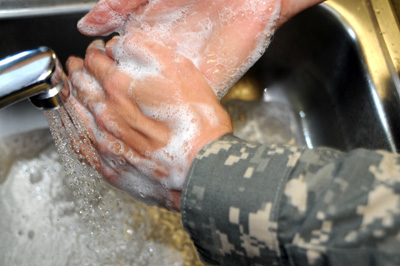By C. Todd Lopez
WASHINGTON (April 28, 2009) -- While emphasizing caution, the surgeon general of the Army said there's no reason to be alarmed by swine flu.
"It's important for you all to understand that there is no cause for panic or alarm," wrote Lt. Gen. Eric B. Schoomaker, U.S. Army surgeon general in his blog. "Antiviral drugs are available in the event you become ill; and there are preventive measures you can take to stay healthy."

The swine flu virus has been confirmed in such places as Mexico, the United States, New Zealand, Canada, Spain and the United Kingdom. There have been deaths in Mexico.
The swine flu usually occurs in pigs, though certain strains can be passed to humans -- and from human to human.
"The most recent cases of swine flu appear to have the ability to be passed from person to person and have resulted in a number of cases in the United States as well as widespread disease in certain parts of Mexico," Schoomaker said. "It is likely that this swine flu will spread to many if not all parts of the United States."
The symptoms of swine flu are similar to other kinds of flu, including fever, cough, sore throat, body aches, headache, chills and fatigue. In some cases, there may also be vomiting and diarrhea.
The swine flu is passed from person to person much like other forms of the flu, Schoomaker said.
"Most people catch swine flu the same way they catch the regular flu," he said. "You can catch swine flu by coming in contact with droplets from infected people after they sneeze or cough. This can occur by being in the path of a sneeze or cough or touching something that has those droplets on it and then touching your mouth, nose or eyes."
Medication like Tamiflu and Relenza can treat the swine flu, Schoomaker said. These medications are not available over the counter, however, but by doctor's prescription.
"If you have swine flu and need treatment, treatment should start within two days after you begin to feel sick," Schoomaker said. Those with chronic medical conditions are at risk for more severe illness from the swine flu, he said.
According to Schoomaker, neither the Army nor the overall military population are showing any unusual spike in illness that might indicate swine flu. Additionally, the general said, he and other senior medical officials in the joint community are staying abreast of the issue in order to keep the force healthy.
"Rest assured that my staff and I are working the swine flu issue closely with the Joint Staff surgeon, the assistant secretary of Defense for Health Affairs, the other military services, Health and Human Services, and Centers for Disease Control and Preventive Medicine," Schoomaker said.
Deployed service members are at no increased risk of infection, according to information released by the Surgeon General's Office.
The Army Medical Command recommends Soldiers and their families avoid contracting the swine flu by avoiding those who already have the flu, and by washing their hands often.
"If you think you have swine flu, contact your health care provider. He or she will be able to determine if you need testing or treatment," Schoomaker said.